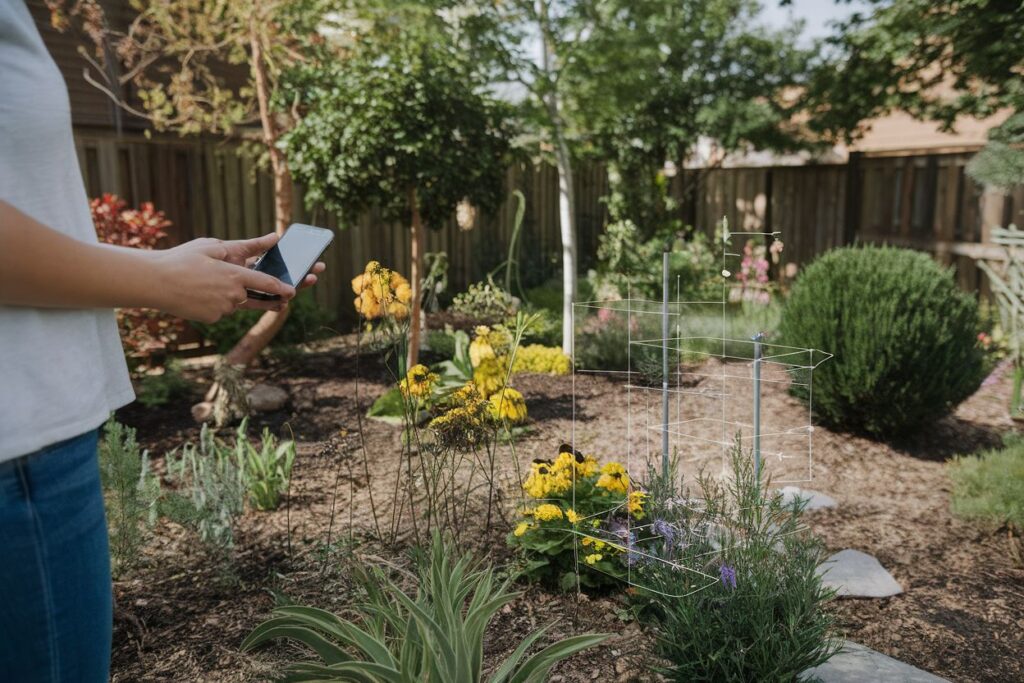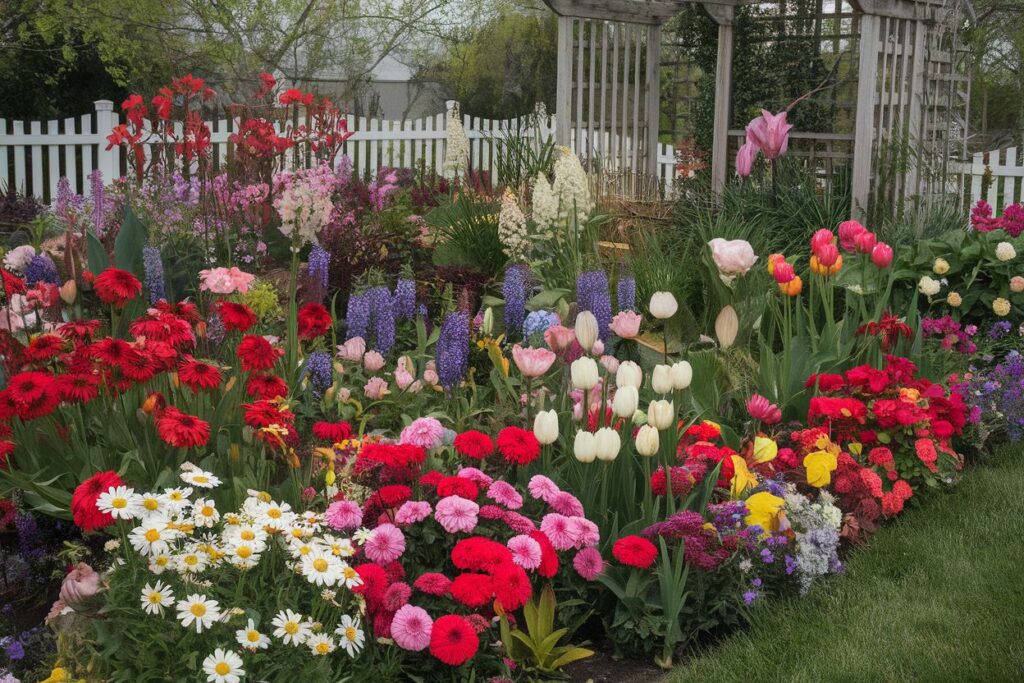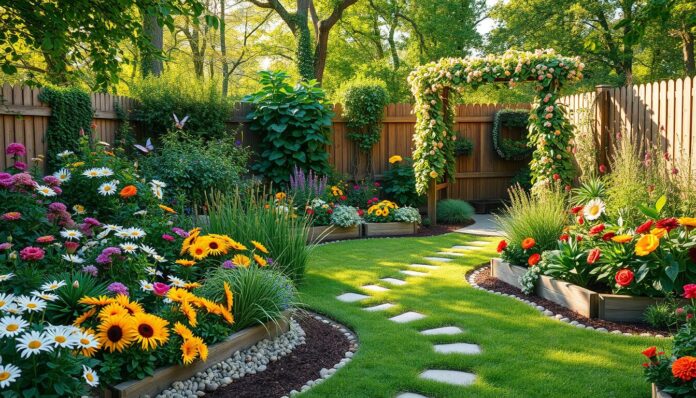Creating a beautiful backyard flower garden can turn your outdoor space into a vibrant sanctuary. Starting a flower garden might seem hard, but with the right planning, anyone can do it. It’s a great way to make your yard stunning.
This guide will show you how to start a thriving flower garden. You’ll learn about picking the best spot and understanding soil needs. You’ll also find out how to make your garden colorful and sustainable.
Good garden planning means being prepared and loving plants. It doesn’t matter if you have a small space or a big yard. The basics of creating a beautiful flower garden are the same for everyone.
By using our detailed approach, you’ll learn to turn any outdoor area into a stunning floral landscape. It will show off your style and connect you with nature’s beauty.
Planning Your Perfect Flower Garden Space
Starting a flower garden needs careful planning and design. It’s not just about picking pretty plants. It’s about knowing your outdoor space and its possibilities. Every gardener wants a garden that’s alive and beautiful all year.
Checking sunlight is key to picking the right plants. Flowers need different amounts of light. Walk your garden at various times to see how the sun moves. Some spots get lots of sun, while others are shaded by trees or buildings.
Understanding Sunlight and Shade Requirements

Mapping your garden helps you see where to plant. Draw a simple map of your yard, marking sunny and shady spots. This map will guide you in placing flowers where they’ll get the right light.
“Know your garden’s light—it’s the blueprint for successful plant growth.” – Professional Gardening Advice
Measuring Your Garden Area
Getting exact measurements is vital for garden planning. Use a tape measure to find out your planting areas’ sizes. Think about width, length, and any obstacles that might affect plants.
Climate Zone Considerations
Knowing your climate zone is crucial for picking plants. The USDA Plant Hardiness Zone Map shows temperature and season info. Find your zone to pick flowers that will do well in your area.
Essential Soil Preparation Techniques
Starting a beautiful flower garden begins with knowing your soil. The first step is to test your soil. This helps identify what nutrients it lacks and its pH level.
“Know your soil, and your garden will thrive” – Professional Gardening Wisdom
Soil amendments are key to making your garden soil rich. A simple soil test kit from your local garden center can tell you a lot. It checks for nitrogen, phosphorus, and potassium, showing what your garden needs.
Compost is a powerful tool for better soil. It adds organic matter, improving soil structure and fertility. You can make compost from kitchen waste, leaves, and grass clippings. Spread 2-3 inches of compost over your bed and mix it into the soil for nutrients.
Preparing your garden bed is more than just adding nutrients. Make sure it drains well by creating raised beds or mixing in organic matter. This helps roots grow and reach water and nutrients better.
Professional tip: Test your soil in early spring or fall for the most accurate results. This gives you enough time to make any needed changes before planting your garden.
Selecting the Right Plants for Your Flower Garden

Creating a stunning flower garden needs careful plant selection. It brings beauty and sustainability to your outdoor space. The right mix of annual and perennial flowers can make your garden vibrant and colorful all year.
Annual vs Perennial Flowers
Annual flowers live for just one growing season. They offer intense color and flexibility in garden design. Marigolds, zinnias, and petunias are favorites that bloom quickly and dramatically.
Perennial flowers, on the other hand, come back year after year. They provide consistent structure and long-term beauty in your garden.
Color Schemes and Blooming Seasons
Designing garden color schemes means understanding when plants bloom. Choosing flowers that bloom at different times ensures your garden stays colorful. Cool blues and purples look great with warm oranges and reds, creating beautiful garden palettes that change with the seasons.
Native Plant Options for Easy Maintenance
Native plants are great for gardeners who want easy care. They are naturally adapted to local climates, needing less water and attracting pollinators. Coneflowers, black-eyed susans, and native wildflowers add ecological value and reduce garden work.
“A well-planned garden is a living artwork that evolves with each passing season.” – Garden Design Expert
Planting and Initial Care Guidelines
To have a thriving flower garden, focus on the planting techniques at the start. Begin by making your garden beds rich and well-draining. Dig holes that are a bit bigger than the plant’s roots, and space them right for each flower type.
“The secret to successful gardening is understanding each plant’s unique needs and providing the right care from the start.” – Expert Gardener
Make a watering plan that fits each plant’s needs. Young flowers need more water, about 1 inch a week. Water deeply but not too often to help roots grow strong.
Mulching is key for keeping soil moist and the right temperature. Put down 2-3 inches of organic mulch around your plants, but not touching the stems. It keeps moisture in, stops weeds, and controls soil heat.
Fertilizing is vital for your plants to grow well. Choose a balanced, slow-release fertilizer for flowers. Follow the instructions on the package, usually at the start and middle of the growing season. Don’t overdo it, as it can harm the roots.
Keep an eye on your plants in the first few weeks. Look for signs of stress and adjust your care if needed. Soon, your garden will be full of color and life.
Final Thoughts
Creating a beautiful flower garden needs dedication, planning, and passion. Understanding your garden’s environment, preparing the soil, and picking the right plants are key. This turns an empty space into a lively landscape.
Flower garden care gets simpler with a solid start and learning about seasonal needs. Each garden has its own story, with colors, textures, and blooms changing with the seasons. Your garden will grow, offering endless joy.
Gardening is a journey of learning and patience, leading to amazing results. Start small, try new plants, and adjust to your climate. This way, your garden will flourish.
Successful gardens come from knowledge, creativity, and care. Whether new or experienced, the basics are the same: know your garden, prepare the soil, choose the right plants, and care for them. A thriving garden brings more than beauty, offering peace and a connection to nature.
Start your gardening journey with an open mind, curiosity, and joy. Your garden will be a living, changing work of art, showing your love and effort.











